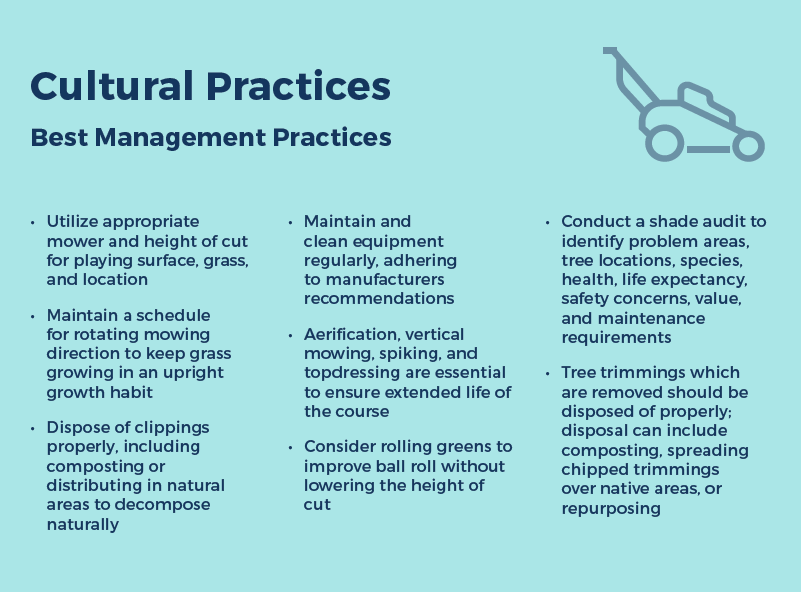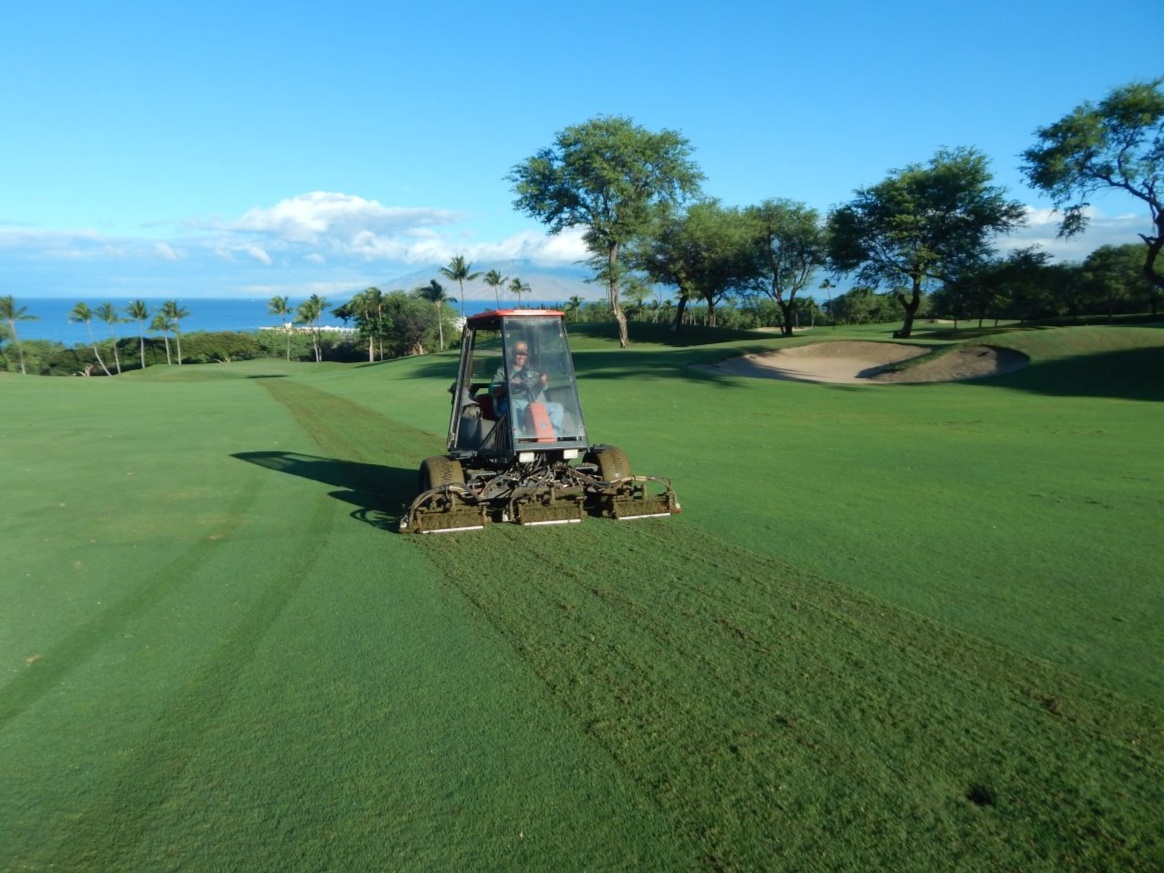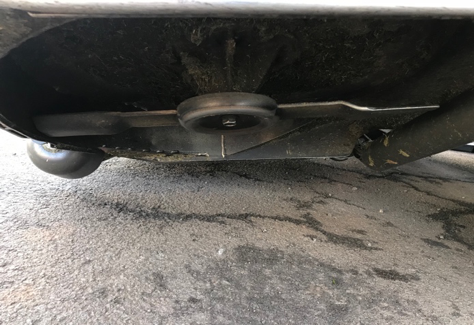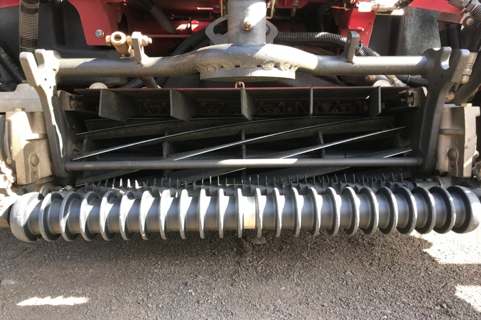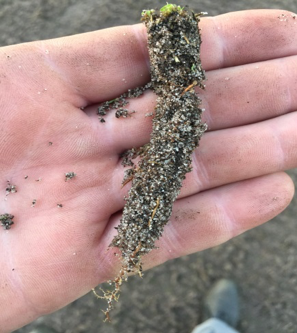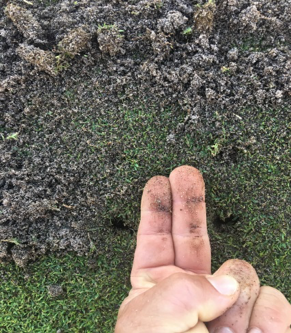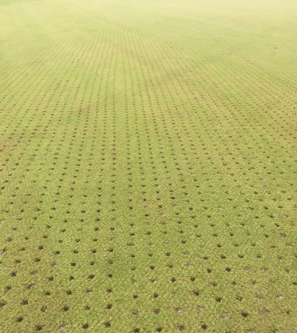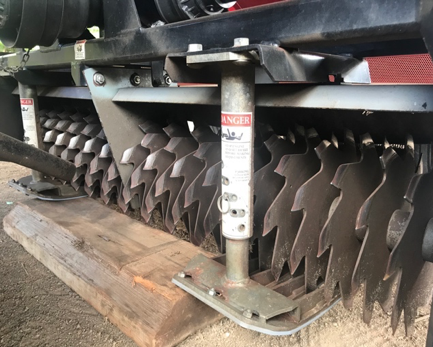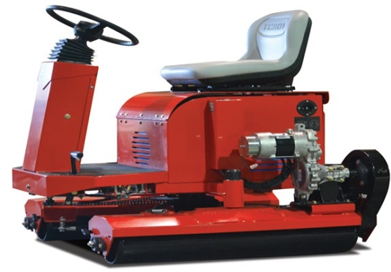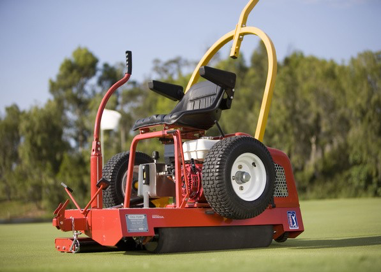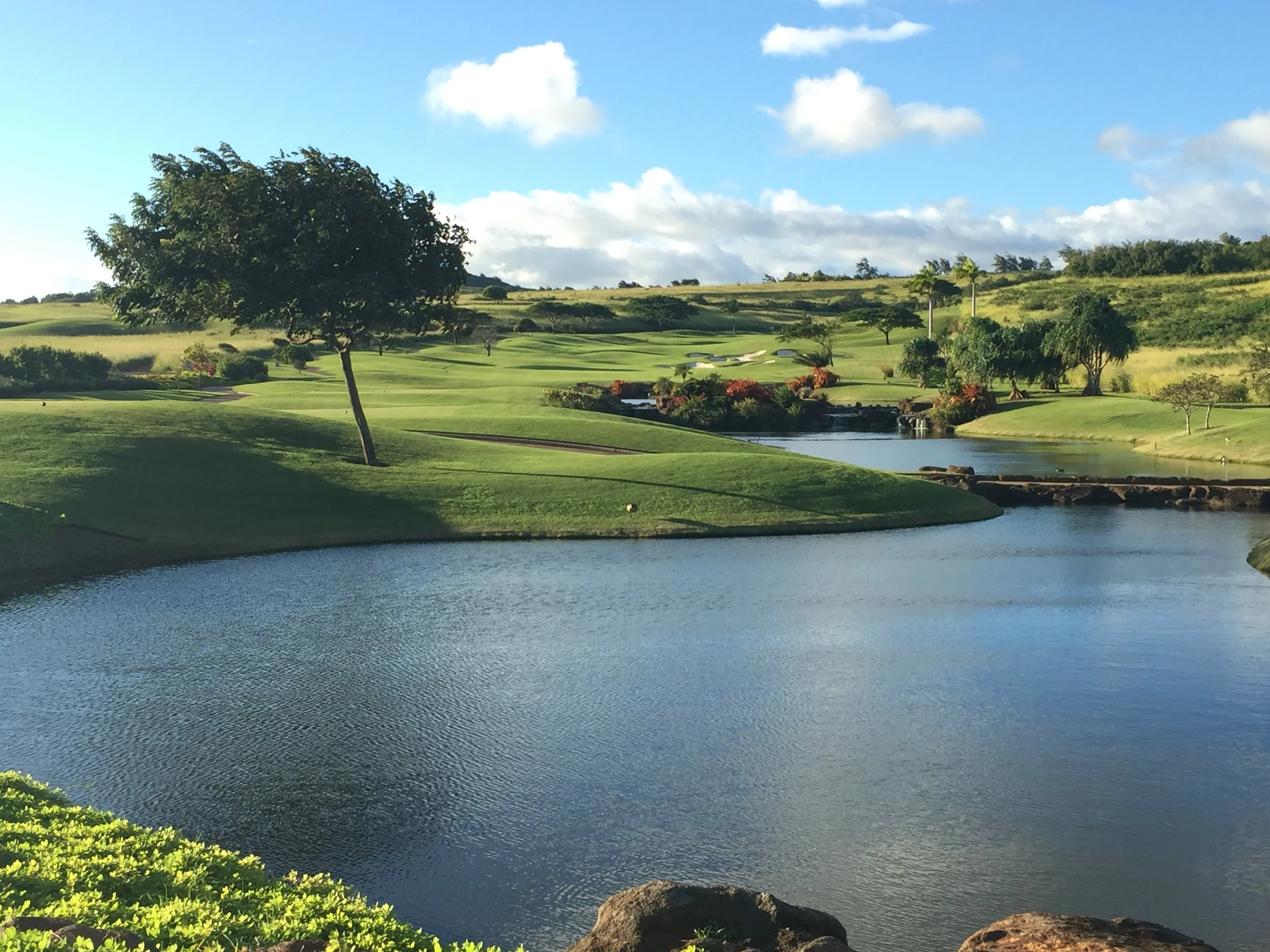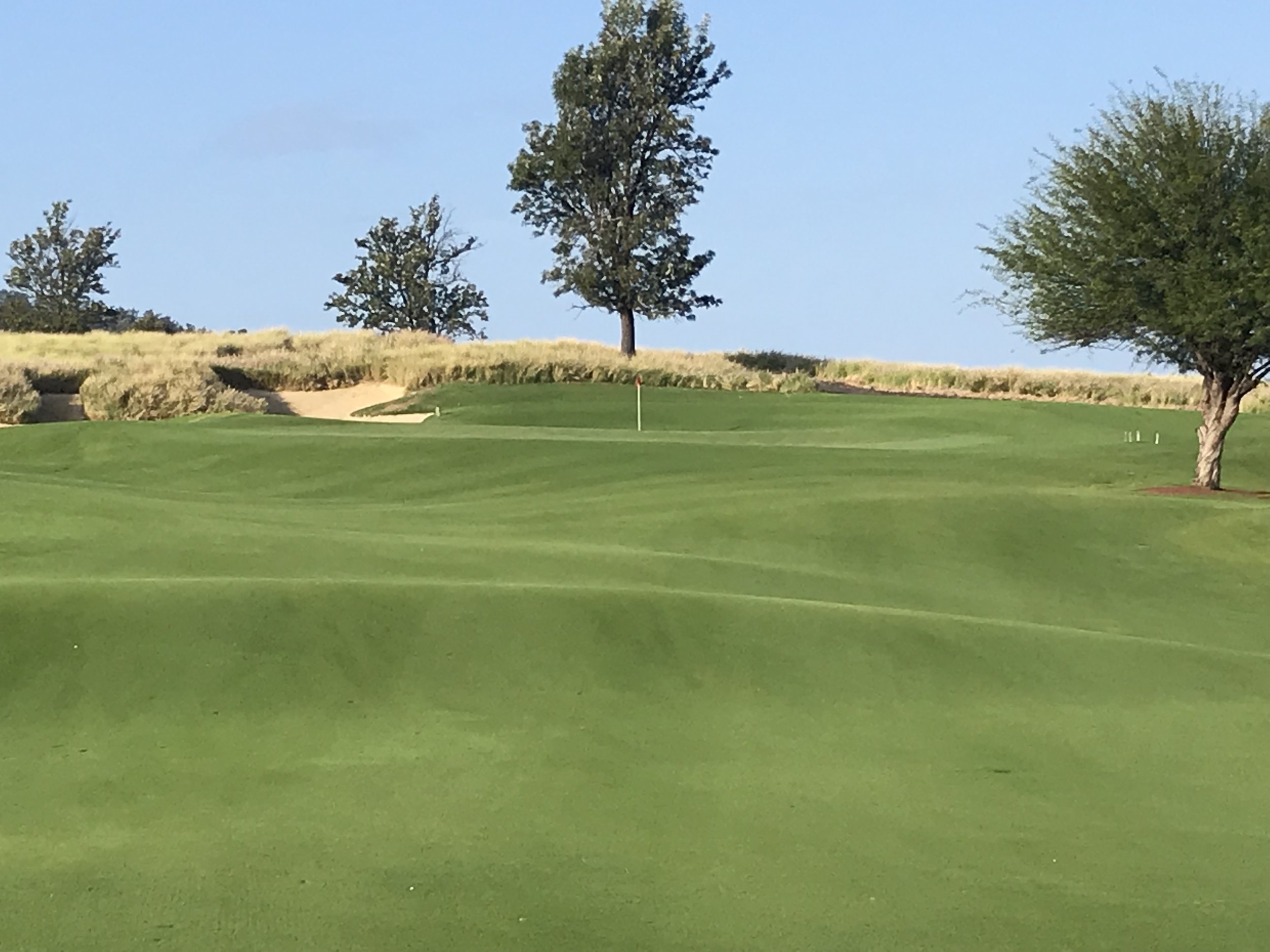8 - Cultural Practices

Cultural practices can have a significant impact on health, playability, and efficiencies of the course.
Cultural turf management practices can vary from one property to the next. Factors such as turf variety, budget, and course expectations have an impact on what practices best meet a facility’s needs. Examples of cultural practices that are frequent and have minimal impact on playing surface include mowing, grooming, and rolling. Other practices such as aerification, spiking, and deep verticutting are used to promote healthy turf, but create a temporary disturbance to the playing surface.
Areas that receive a high level of foot traffic, such as a putting green, deteriorate over time due to soil compaction, thatch accumulation, and day-to-day stress. These soil issues are usually found in the top three inches of the soil profile. In this section we talk about different cultural practices and the importance behind them.
MOWING
Mowing is the most fundamental practice on a golf course to create a desirable playing surface. It has advanced over the years to become a science in achieving lower heights and better cut quality. With a quality cut, you improve the health of the plant by cutting the leaf blade, instead of pinching or tearing the blade. This improves look and playability of the turf dramatically. Mowing practices can affect turf density, texture, color, root development, and wear tolerance. The greater frequency of a surface being mowed increases turf density, but at the same time can decrease root and rhizome growth, due to stress from the mower removing lead tissue.
Types of Mowers
There are two types of cutting units used for mowing turf: reel mowers and rotary mowers. A reel mower is a cylinder with eight to 16 blades evenly spaced and a sharp stationary bedknife mounted under the reel. As this cylinder spins, the grass is cut like a pair of scissors between the blade and bedknife. If the mower is adjusted properly it will provide the highest cut quality and lowest mowing heights available. Reel mowers require less power allowing for fuel savings or battery-operated options. There are a few disadvantages to a reel mower such as height-of-cut options, plus the amount of maintenance and skill it takes to adjust properly.
Rotary mowers have blades that mount horizontally to a vertical shaft and spin at high speeds. The impact from the sharp blade contacting turf cuts the leaf blade. So rather than a scissor cut, you get a knife cut. This works well for grass being maintained at higher heights as long as the blade is sharp. The rotary mower also has as few disadvantages such as inability to mow below one inch and danger associated with the swinging blade.
Height of Cut
Golf courses have multiple playing surfaces that require varying frequency and height-of-cut. For example, most courses will use a rotary mower set anywhere from one to two inches for height-of-cut on roughs. On average, rough will be mowed once or twice per week. This varies based on time of year and how fast grass is growing. In winter, temperatures are cooler, and days are shorter - as a result, there is less opportunity for the plant to photosynthesize, so the plant does not grow as fast. During summer months, temperatures are higher, and days are longer. The opportunity for the plant to photosynthesize makes for rapid growth and additional mowing. If turf is not mowed frequently enough, you will scalp. As a guideline, mow often enough to ensure no more than one-third of the top growth is removed at any one time.
To mow the remaining golf course requires reel mowers. Areas such as the tee, fairway, and approaches are maintained around 0.5 inch or less. Due to the height of cut and importance of playability, it is not uncommon for these areas to be mowed two or three times per week. Like the rough, time of year and growing conditions can vary this practice.
The most important aspect of a golf course is the greens. Greens have the highest priority and receive the most maintenance. Golf course greens are always mowed with a reel mower that needs to be frequently adjusted and sharpened. Mowing heights are much lower and require daily attention. Most courses will mow daily or substitute with a roller on occasion. To have a quality playing surface, the cut quality, frequency, and mowing height have huge impacts. Average mowing heights for greens range from .07 to .125 inch.
Recommended Golf Course Mowing Heights, by Area
Unruh, Cisar, and Miller, 1999.
Mowing Directions
Varying mowing directions is very important to keep grass growing in an upright growth habit and provide a smooth playing surface. By rotating directions, grass is prevented from lying over and growing in the direction it is being mowed. Lateral growth habit creates what is called “grain” which creates inconsistent ball roll speed and can influence the ball to roll in the direction the grass is growing - the mower will eventually create a very poor cut and accumulation of thatch will create marcelling. Marcelling is a wavy or washboard look that occurs over time and creates unfavorable playing conditions. Another issue that can arise is “rutting” from tires going over the same spot repeatedly, creating wear and soil compaction. This is why most courses will have a chart showing the daily mowing direction. For example, based on the position of a clock, Monday might be 12 to 6, Tuesday 3 to 9, Wednesday 8 to 2 and Thursday 10 to 4. Rotation ensures grass is consistently mowed in a different direction and helps operators see the lines to provide the ability to create a checkerboard pattern. Mowers with a roller will lie the grass over the direction of mowing. This creates a striping effect from light to dark. The light-colored pass is the direction moving forward and the dark pass is the opposite.
Grass Clippings
With all of this mowing, what happens to the clippings? With frequent mowing most courses will not pick up clippings in large areas, such as the rough and fairways. If there is a lot of debris behind the mower, blowers will disperse clippings and provide a clean playing area. This reduces costs and improves waste management because clippings contain nutrients that grass can use, and it can cut the amount of fertilizer needed. Areas where clippings are removed include places where balls roll, such as the greens, tees, and approaches.
Removed clippings should be disposed of properly. Courses can compost clippings or distribute them in native areas to decompose naturally.
Equipment Care
Equipment in Hawai’i does not last as long as most places. Courses are open year-round so machine operating hours add up quickly. The tropical climate also takes a toll on equipment with sun and salt air breaking it down over time. This is why equipment care and operating leases are incrementally important in Hawai’i. Storing equipment under cover helps extend life, in addition to proper preventative maintenance based on manufacturer’s recommendations. Washing and waxing equipment after every use helps prolong appearance and life of the machines. To achieve the mowing heights desired and get the cut quality expected, it takes trained personnel to sharpen and maintain equipment.
TURFGRASS CULTIVATION PRACTICES
In order to maintain a healthy playing surface, cultural turf maintenance practices are implemented. These practices provide an opportunity for both turf and soil to recover from daily play. During the year, soil conditions can become very compact from cart and foot traffic, creating unfavorable growing conditions. Another common issue over time is the accumulation of thatch that builds from years of organic matter. Thatch is found under green vegetation and above the soil which is made up of dead and living shoots, stems, and roots. The goal is to have a healthier plant by providing relief to the soil compaction, reduce thatch, and improve water and air exchange. Some of these practices result in disturbance of the playing surface and can require weeks to fully recover. Equipment has advanced through the years, providing ways to manage these issues, while minimizing impact to playing conditions. Practices such aerification, vertical mowing, spiking, and topdressing are essential to ensure extended life of the golf course.
Aerification
Core Aerification is a common practice done on any surface where soil compaction is an issue. Soil compaction normally occurs in the top 3 inches of a profile and can create an unfavorable environment for plant roots to grow. Because of the lack of oxygen getting to the plant roots, it is a struggle to carry out respiration, which is necessary for the plant to convert stored food to energy and vital for survival.
Specialized machines called aerifiers have the ability to pull multiple soil cores from the turf surface in a timely manner. This practice provides the ability to physically remove unwanted organic matter from the upper portion of the root zone. Aerifiers provide important health benefits:
Reduce compaction and removal of thatch
Provide oxygen to the roots
Allow water infiltration
Reduce dry spots
Minimize water runoff
This process normally occurs two to three times per year on heavy traffic areas such as greens, tees, fairways and approaches.
The size of the tine can vary in diameter and length. Common sizes are 0.25 to 0.75 inch inside diameter at a depth of three to four inches, with two to 2.5 inch spacing. You will remove more thatch with a large tine, at closer spacing, however recovery time will increase. Due to surface disruption, recovery time, and cost, it is not uncommon for courses to push for less frequent or smaller-tine core aerations. Over time this can have long-term negative effects costing more in the long run. Ideally try to impact 15 to 20 percent of the green surface every year with core aerification to promote a well maintained green in Hawai’i.
Technology and equipment aerification advancements have improved, offering new options to meet varying needs. Deep tine aerification with a solid tine is becoming very popular. It provides the ability to reach a depth of 10 inches or greater with a tine’s diameter from .125 to 1 inch. The spacing and angle in which the tine enters and exits the holes can be adjusted. These options do not remove any material and are quick to recover, while still providing positive health benefits. Determining what type, size, and depth of aerification can vary by property depending on what option will best solve the existing problem.
Vertical Mowing
Vertical mowing has increased in popularity amongst warm season turf varieties. A vertical mower is a series of knives that vertically mount on a horizontal shaft and spin at a high rate. The blades are made to slice though turf while pulling out thatch and debris. Depth can be adjusted to tickle or rip as much as necessary. As soon as thatch levels reach 0.25 to 0.5-inch depth, initiate a vertical mowing program.
Verticutting is incorporated into almost every cultural program in Hawai’i because of the aggressive nature of Bermuda and Paspalum having a lateral growth habit. On putting surfaces this lateral growth is called “the grain of the green”. To minimize grain on the putting surface, knives are adjusted to a depth that just nicks the surface of the green. This light, frequent verticutting will have minimal impact on play and help minimize the grain. Deep verticutting on a putting green surface may be performed, however because of the potential damage that can occur and extensive recovery time, managers should use extreme caution and test the practice before implementing. Shallow verticutting on greens may be implemented one to two times per month. New ultradwarf varieties may require even more frequent vertical mowing to prevent excessive thatch build up. To meet this demand, interchangeable vertical mower units are available for triplex greens mowers. This allows for quick and precise verticutting of the green surface while collecting debris in the basket at the same time. The blades are spaced 0.25 to 0.5 inches apart. Verticutting directions should be rotated similar to daily mowing.
Grooming and brushing are options to provide light grooming to the putting surface. Miniature vertical mowers are attached in front of the reel cutting unit and grooming can be done in conjunction with daily mowing. This helps improve playing surface by standing up leaf blades before the reel cuts it. It is another way to help reduce surface grain.
On areas such as rough, fairways, and tees verticutting can be conducted at deeper depths for thatch removal to help provide a smooth, firm playing surface. Figure A demonstrates what can happen over time if turf is mowed in the same direction and thatch is not managed.
Figure A
Adjust the depth so blades can reach the bottom of the thatch layer and extend into the soil below the thatch. This aggressive depth can stimulate new growth by cutting through stolons and rhizomes while removing unwanted thatch. When going this deep, set blade spacing one to two inches apart to maximize thatch removal and minimize damage. (Reference Figures B and C.) When verticutting in multiple directions, use perpendicular angles to lessen the occurrence of damage from too aggressive removal.
Topdress
Topdressing is an important cultural practice to make the putting surface meet player expectations. Adding a thin layer of sand to the turf surface, followed by dragging or brushing, provides multiple benefits to the putting surface. There is a common misconception by players that topdressed greens disrupt play, however without it, the quality of the putting green would diminish over time.
Topdress programs are unique and need to work for what you are trying to achieve. On putting greens, it is common for courses to apply light, frequent applications of topdressing sand to help smooth out the playing surface and aid the breakdown of thatch. This process can be done one to two times per month. A light sand topdressing program establishes smooth playing surfaces, controls thatch and grain, and promotes recovery from injury.
After cultural practices, such as core aerifing and verticutting, follow up with a topdress application. Sand is used to fill, smooth, and speed recovery of turf. The amount of sand can vary depending on capacity of the turf canopy to absorb material without burying the plant. Rates vary from 0.125 to .25 inch (two to four cubic yards of soil per 5,000 square feet) or until surface is smooth and level after dragged in. Filling holes after core aerfication might require a couple applications to ensure holes are filled to the top without smothering the turf.
Make sure the sand particle matches the greens profile in shape and size when purchasing. If the sand is a finer material it can create layering and have a negative impact on water infiltration. This is known as perched water table and can be very difficult to get rid of. Surprisingly, sand is very expensive in Hawai’i because it is imported. The majority of the silica sand used in Hawai’i is from Asia.
Rolling
Rolling greens has increased in popularity over the past few years. Daily rolling of a putting green can increase putting speeds by roughly 10 percent allowing for improved ball roll, without lowering the height-of-cut. Any time height-of-cut is raised, turf is healthier. Rolling also helps improve smoothness of the ball roll by pushing down imperfections. Research has proven that more rolling contributes to less weeds and occurrence of dollar spot, a common disease.
There are two types of rollers being used today: stand-alone rollers and triplex rollers replace the reels with roller units. Stand-alone units come in different weights and sizes. When operating, the driver faces perpendicular to the direction they move. In Figure D you can see a heavy roller compared to a light roller in Figure E. These rollers require a cart or large utility vehicle to pull from location to location.
If you use a heavy roller you could risk issues such as soil compaction thus affecting air and water movement through the profile. For this reason, light weight rollers are recommended. It is not wise to roll with a heavy roller after a heavy night of irrigation. To further prevent compaction, extra aerification may be required to relieve any soil issues. If done properly, rolling has numerous benefits and can help create that extra speed often desired.
Shade and Tree Management
One of the most important factors for turf to survive is sunlight. Full sun provides increased photosynthesis and improves air circulation. This aids in evaporation of moisture, decreasing the susceptibility of pest and disease potential. Factors such as trees can substantially reduce air circulation and sunlight to surrounding turf. This often creates shaded areas, stagnant air, and leaf blades that stay wet for an extended period of time. As temperatures increase throughout the day, shady areas become warmer and more humid, compared to open areas. This results in weaker turf that is thin and more prone to pest and diseases. To minimize issues, observe the sun pattern and see what trees are blocking light from reaching desired areas throughout the year. Selectively remove branches to open up air and light; if the problem is severe, it may be necessary to remove select trees.
Conduct a shade audit annually to identify problem areas. Identify each tree location, species, health, life expectancy, safety concerns, value, and maintenance requirements. If removing or pruning trees is not an option, there are still a few things which can be done:
Increase mowing height by at least 30 percent to provide more surface area to capture light and improve benefits for roots
Reduce fertilizer applications to avoid depleting the carbohydrate source for the plant
Monitor irrigation and prevent the shaded area from getting too wet
Prevent traffic from going into shaded areas through using signage or rope and stakes
Add fans set with timers to dry the area and provide fresh air movement across surface
These measures can help minimize damage and provide a weak plant the best opportunity to survive. In the event trimmings are removed, they should be disposed of properly. Disposal can include composting green waste, spreading chipped trimmings over native areas, or cutting wood that falls into logs to provide to employees, local woodshops, or chefs for carving, barbecue smoking, or grilling.

